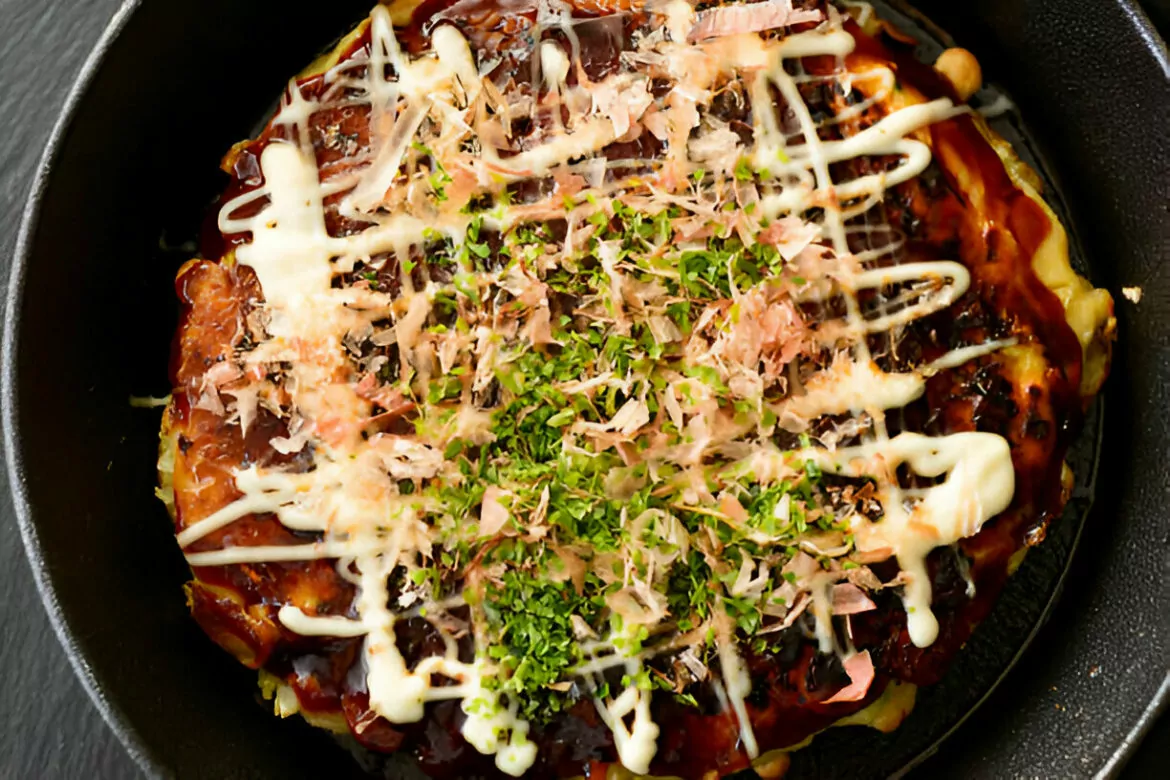Okonomiyaki, often called a Japanese savory pancake, is a versatile dish that brings together fresh cabbage, a flavorful batter, and optional protein such as chicken. This recipe is easy to prepare and topped with traditional garnishes like okonomiyaki sauce, mayonnaise, aonori flakes, and bonito flakes, making it a perfect centerpiece for a delightful meal.
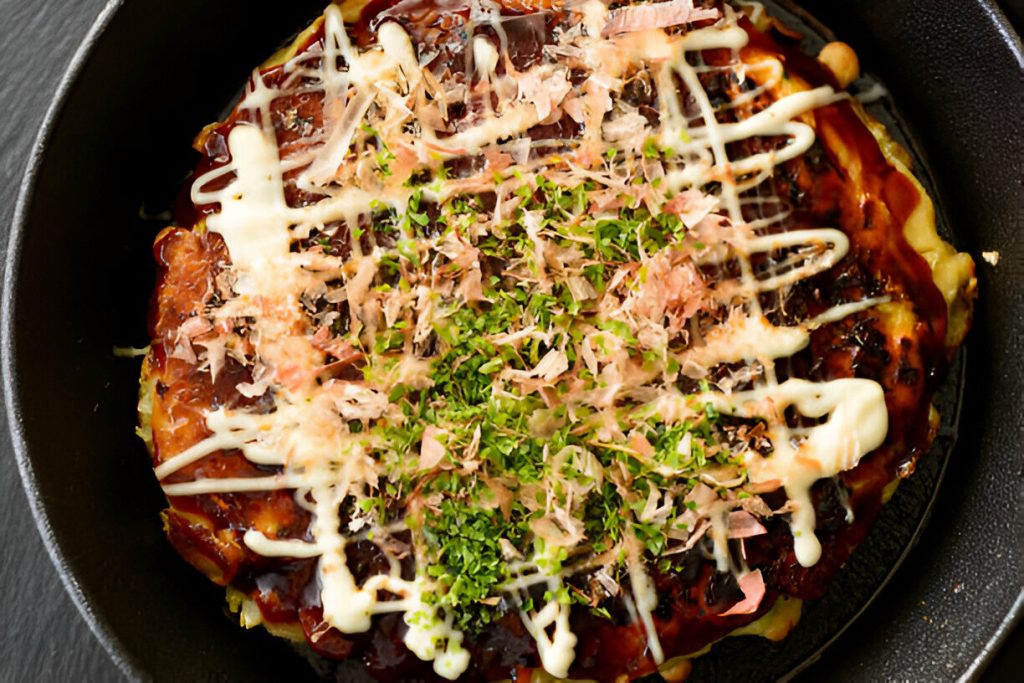
Ingredients Overview
The heart of this dish lies in the harmonious balance of simple yet impactful ingredients. The batter, made from flour, dashi stock, eggs, and a touch of sugar, creates a light but sturdy base. Adding finely sliced cabbage ensures the pancake has a satisfying crunch while spring onions contribute a mild, sweet onion flavor.
Chicken breast, while optional, adds protein and transforms the pancake into a hearty dish. For finishing touches, garnishes such as creamy mayonnaise, tangy okonomiyaki sauce, umami-rich bonito flakes, and aromatic aonori seaweed elevate the dish to a traditional Japanese experience.
Step-by-Step Preparation Guide
Begin with the chicken if using it as an optional ingredient. Heat sunflower oil in a large frying pan over medium heat and stir-fry the finely sliced chicken until it’s golden and cooked through. Remove the chicken to a plate and wipe the pan clean to prepare for the pancake. Ensuring the chicken stays moist is key to complementing the dish without overpowering the other flavors.
Next, prepare the batter by whisking together flour, water, dashi stock granules, caster sugar, baking powder, Kosher salt, and eggs. The resulting mixture should be smooth but forgiving if a few tiny lumps remain. Folding in the cabbage and spring onions ensures even coating, creating a batter that clings perfectly to the vegetables. The balance between batter and vegetables is essential for achieving the ideal consistency.
To cook the okonomiyaki, heat the remaining sunflower oil in the frying pan over medium heat. If using chicken, layer half the cabbage mixture in the pan, spread it evenly, and place the chicken slices over the batter. Top with the remaining cabbage mixture, pressing it down with a spatula to form a cohesive pancake. For a vegetarian version, pour all the cabbage mixture into the pan at once and flatten it evenly.
Cover the pan with a lid to promote even cooking, and if possible, use a smaller heavy lid to gently press the pancake. Cook for 7–10 minutes until the pancake is lightly set, then flip it over carefully with a spatula. Continue cooking uncovered for another 7–10 minutes, flipping occasionally as needed to ensure the pancake is fully cooked. The center should reach a piping hot temperature of around 85°C.
Once done, transfer the pancake to a serving plate and generously garnish with mayonnaise, okonomiyaki sauce, aonori flakes, and katsuo bushi bonito flakes. Serve immediately to enjoy the full flavor and texture of this delightful dish.
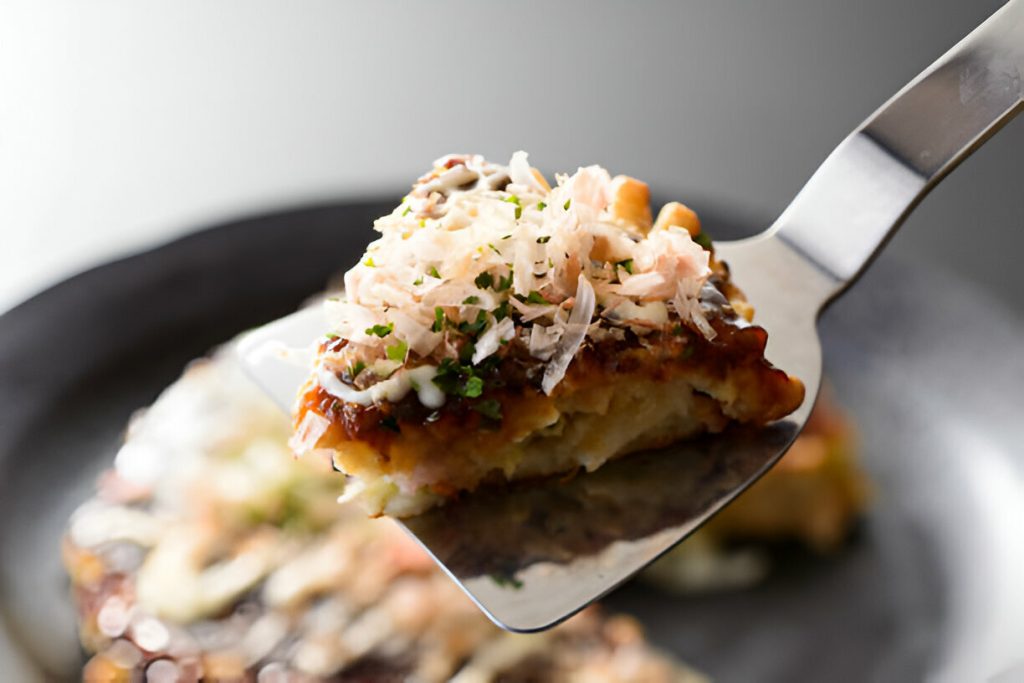
Recipe Tips
Use two spatulas for an easier and safer flip, especially with a large pancake.
If the batter feels too thick, add a tablespoon of water to loosen it. For a thinner batter, add an extra tablespoon of flour.
A digital thermometer can help confirm doneness, ensuring the center is fully cooked without overcooking the edges.
What to Serve With This Recipe
Pair okonomiyaki with a warm bowl of miso soup or a crisp green salad to create a balanced meal. For drinks, green tea adds a refreshing contrast, while sake or a light Japanese beer complements the savory and umami flavors beautifully.
Frequently Asked Questions
Can I substitute the dashi stock granules for another ingredient?
Yes, chicken or vegetable stock powder can be used, though the flavor will differ slightly.
What are alternative proteins if I don’t want to use chicken?
Shrimp, thinly sliced pork, or tofu are excellent substitutes for variety.
How do I store leftover okonomiyaki, and can it be reheated?
Store in an airtight container in the refrigerator for up to two days. Reheat in a skillet or oven to preserve its crisp texture.
Storage and Reheating Instructions
Leftover okonomiyaki should be cooled completely before storage. Place it in a container or wrap it tightly to prevent drying out. Reheat in a skillet over low heat or in a preheated oven until warmed through, maintaining the pancake’s crispy edges.
Okonomiyaki is a versatile dish that allows for endless creativity. Try adding shrimp, thinly sliced pork, or cheese for a unique twist. This recipe is perfect for casual dinners, lunch gatherings, or even as a showstopper at a themed meal. With its customizable nature, okonomiyaki is sure to become a beloved staple in your kitchen.
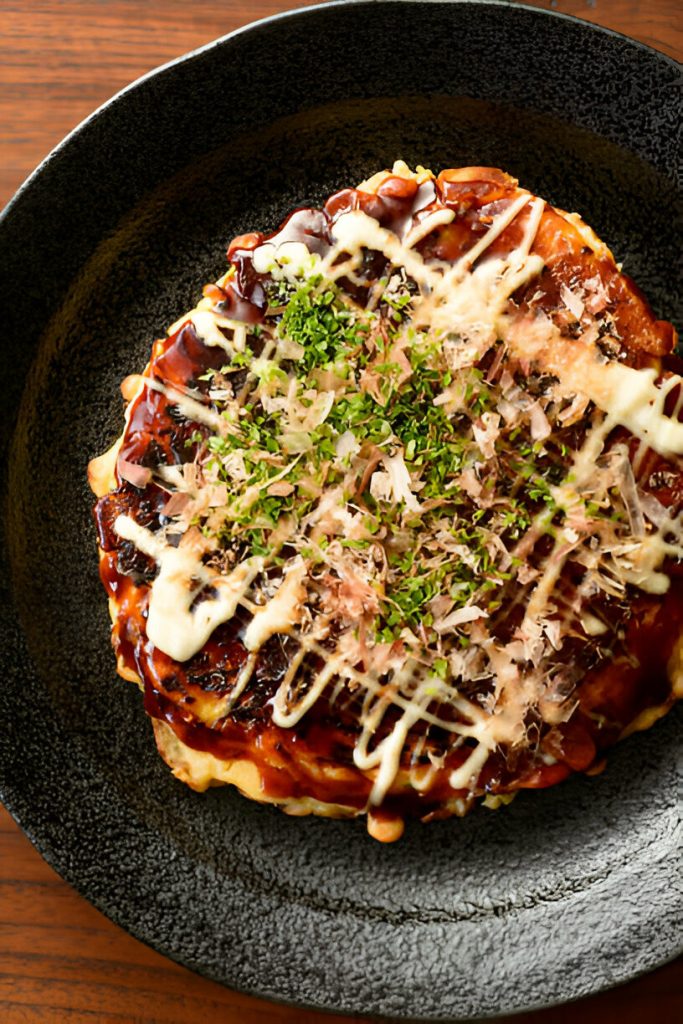
Ingredients
140g plain flour
175g water
5g sachet (1 1/2 tsp) dashi stock granules
2 tsp caster sugar
1/2 tsp baking powder
1/2 tsp Kosher salt
2 medium eggs
400g finely sliced white cabbage (half a small head of cabbage, trimmed)
4 spring onions, sliced on the diagonal
200g chicken breast, finely sliced (optional)
3 tbsp sunflower oil
Instructions
If using chicken, begin by cooking it. Heat 1 tablespoon of sunflower oil in a large 28cm frying pan over medium heat. Stir-fry the sliced chicken until fully cooked and golden. Transfer the chicken to a plate and wipe the pan clean with a paper towel.
In a large mixing bowl, combine the flour, water, dashi stock granules, caster sugar, baking powder, Kosher salt, and eggs. Whisk the mixture thoroughly until smooth; a few tiny lumps are acceptable. Fold in the finely sliced cabbage and spring onions, mixing until the vegetables are evenly coated with the batter.
Heat the remaining sunflower oil in the frying pan over medium heat. If you’re using chicken, pour half of the cabbage mixture into the pan, spreading it evenly with a spatula. Arrange the cooked chicken slices evenly on top, then pour the remaining cabbage mixture over the chicken, ensuring the chicken is encased in the batter. If skipping the chicken, simply pour all the cabbage mixture into the pan at once, flattening it with the spatula for an even pancake.
Cover the pan with a lid to help the pancake cook evenly. If available, use a smaller, heavy round lid to press gently on the pancake. Cook for 7–10 minutes, or until the pancake is lightly set. Carefully flip the pancake over with a spatula, and cook uncovered for an additional 7–10 minutes. Check that the pancake is thoroughly cooked by ensuring the center reaches a piping hot temperature of around 85°C. You may need to flip the pancake a couple more times, cooking for a few extra minutes on each side to achieve the desired doneness.
Once cooked, transfer the okonomiyaki to a serving plate. Garnish generously with mayonnaise, okonomiyaki sauce, aonori seaweed flakes, and katsuo bushi bonito flakes for a traditional finishing touch. Serve immediately and enjoy!
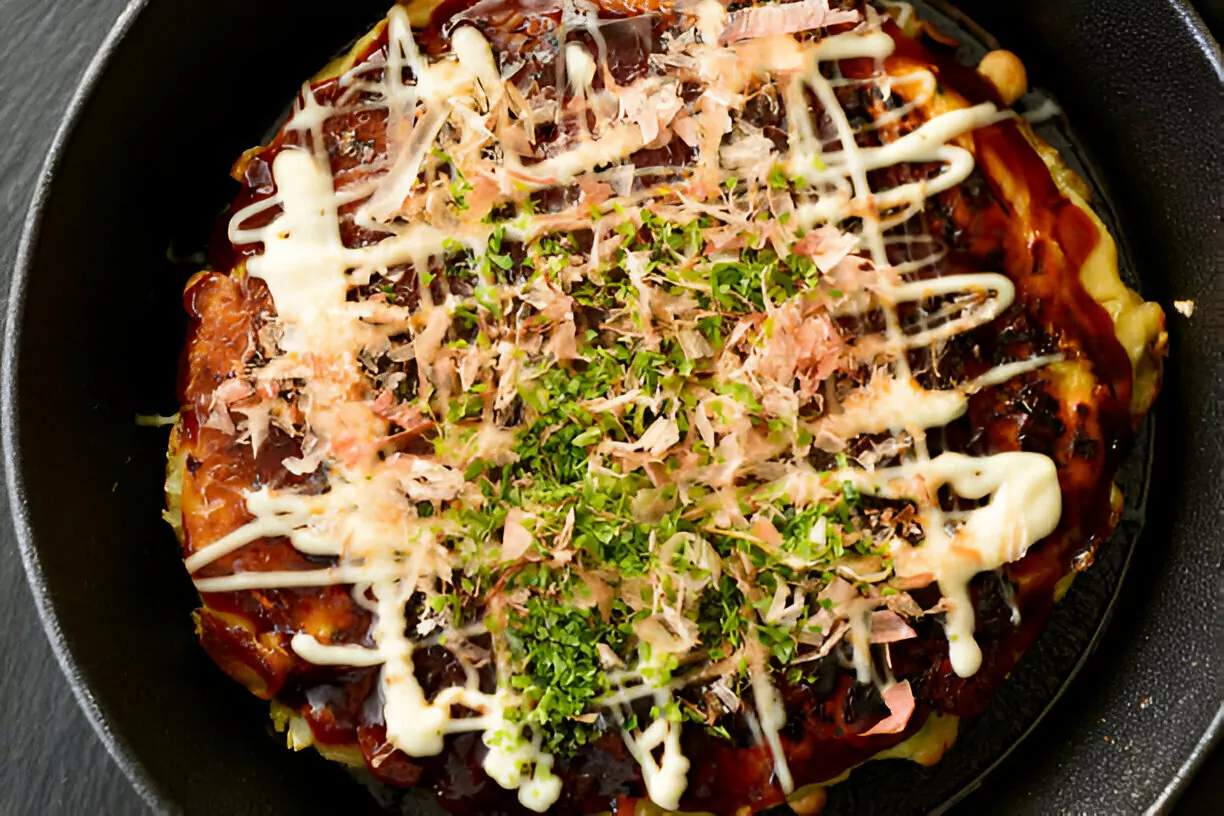
Japanese Okonomiyaki Recipe
Ingredients
- 140 g plain flour
- 175 g water
- 5 g sachet 1 1/2 tsp dashi stock granules
- 2 tsp caster sugar
- 1/2 tsp baking powder
- 1/2 tsp Kosher salt
- 2 medium eggs
- 400 g finely sliced white cabbage half a small head of cabbage, trimmed
- 4 spring onions sliced on the diagonal
- 200 g chicken breast finely sliced (optional)
- 3 tbsp sunflower oil
Instructions
- If using chicken, begin by cooking it. Heat 1 tablespoon of sunflower oil in a large 28cm frying pan over medium heat. Stir-fry the sliced chicken until fully cooked and golden. Transfer the chicken to a plate and wipe the pan clean with a paper towel.
- In a large mixing bowl, combine the flour, water, dashi stock granules, caster sugar, baking powder, Kosher salt, and eggs. Whisk the mixture thoroughly until smooth; a few tiny lumps are acceptable. Fold in the finely sliced cabbage and spring onions, mixing until the vegetables are evenly coated with the batter.
- Heat the remaining sunflower oil in the frying pan over medium heat. If you’re using chicken, pour half of the cabbage mixture into the pan, spreading it evenly with a spatula. Arrange the cooked chicken slices evenly on top, then pour the remaining cabbage mixture over the chicken, ensuring the chicken is encased in the batter. If skipping the chicken, simply pour all the cabbage mixture into the pan at once, flattening it with the spatula for an even pancake.
- Cover the pan with a lid to help the pancake cook evenly. If available, use a smaller, heavy round lid to press gently on the pancake. Cook for 7–10 minutes, or until the pancake is lightly set. Carefully flip the pancake over with a spatula, and cook uncovered for an additional 7–10 minutes. Check that the pancake is thoroughly cooked by ensuring the center reaches a piping hot temperature of around 85°C. You may need to flip the pancake a couple more times, cooking for a few extra minutes on each side to achieve the desired doneness.
- Once cooked, transfer the okonomiyaki to a serving plate. Garnish generously with mayonnaise, okonomiyaki sauce, aonori seaweed flakes, and katsuo bushi bonito flakes for a traditional finishing touch. Serve immediately and enjoy!

